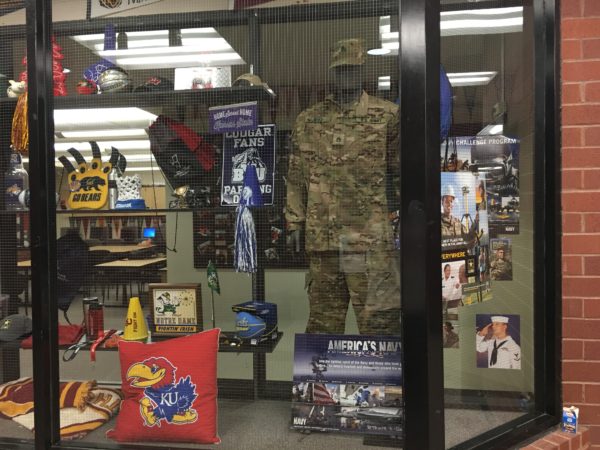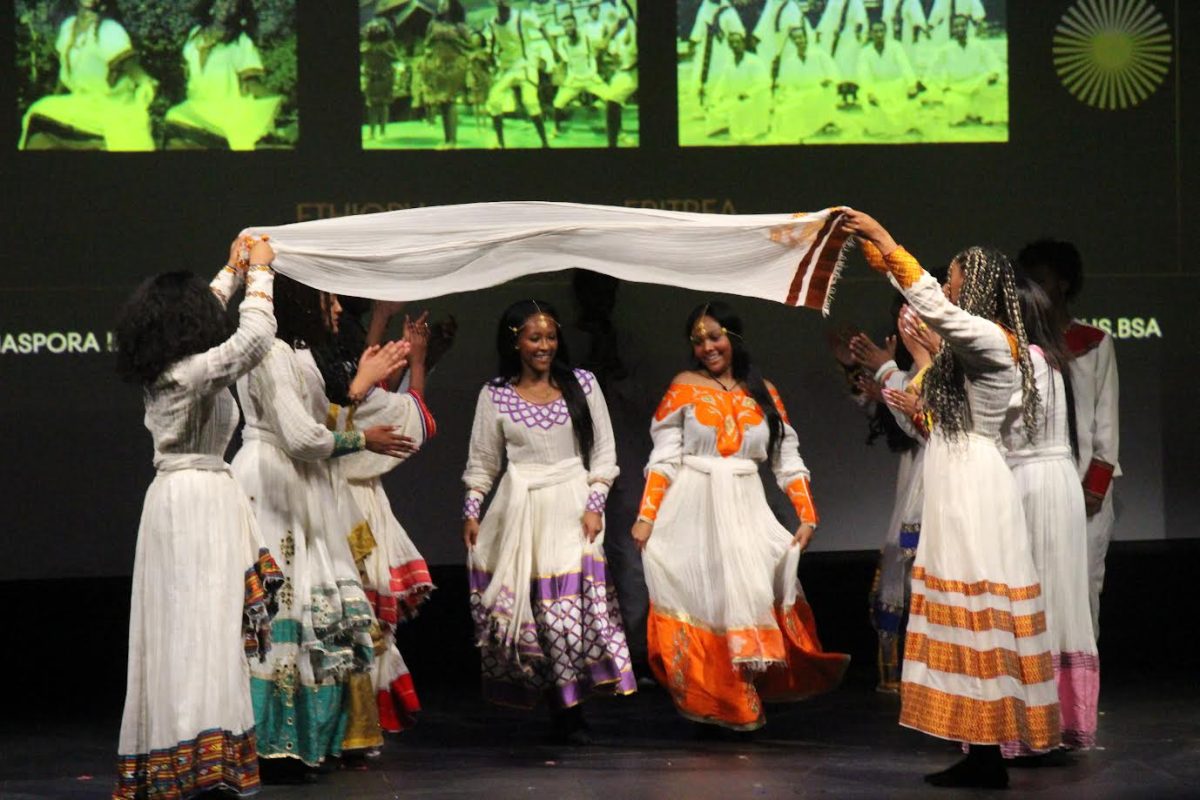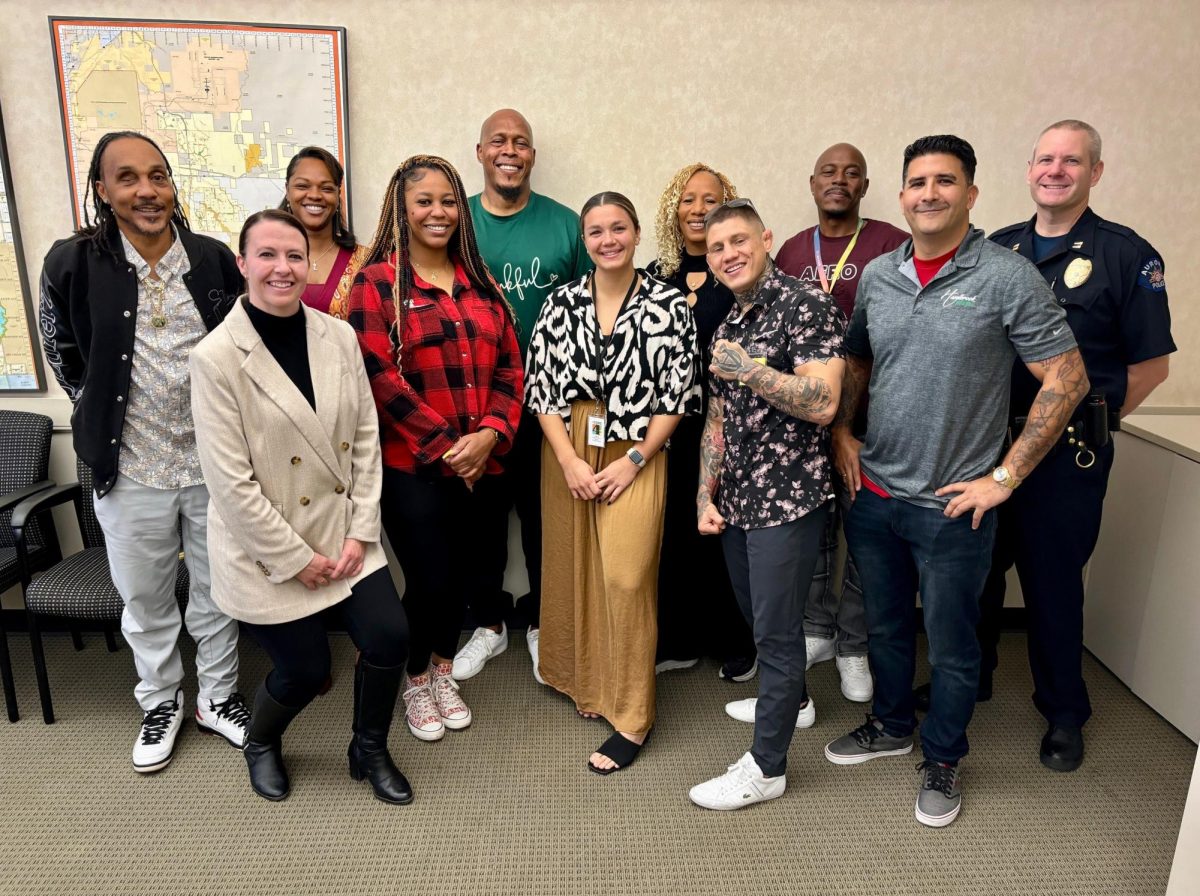Feature Photo By: Dennae Pigford- Within the display case outside of the College and Career Center, there is a section devoted to military representation. A few things within this are a standing military uniform, military memorabilia, and ways to get more information about military involvement.
Ever notice that table outside of the commons during lunch time, full of post-graduation military service information? It is equipped with two military recruiters standing ready to fill your mind with information and possibilities. Ever find yourself wanting to stop by and take a look, but never have because you were in a hurry? Military
recruitment in schools is a topic that some may say requires a little bit more than a “drive-by” information session during lunch hours or a few minute presentation by a military recruiter during a class.
As a matter of fact, before the terrorist attack on the Twin Towers in New York City on September 11th, 2001, military recruitment in schools was illegal, according to multiple sources. The Patriot Act of 2001, passed by President George W. Bush, changed this law. Its full title reads, “Uniting and

Strengthening America by Providing Appropriate Tools Required to Intercept and Obstruct Terrorism Act of 2001.”
This act being passed affected the process as well as the density of military recruitment among United States citizens. As a result, military recruitment in schools was born nationwide, but is it really necessary to have military recruiters inside of public high schools like Rangeview or should potential recruits be trusted to seek out military service on their own through the internet or at a recruitment office?
“17-21, that’s our primary market. But someone the age of 39 could also join,” commented United States Navy recruiter Rondell L. Bethelmy, who recruits Rangeview several times a month. “You serve 20 years and you can retire. So if we get someone who’s 17, they can serve all the way up to 37, and even longer if they wanted to. But the younger they are, the longer they have to stay.”
Military recruitment at Rangeview is represented in two main ways: Students can either stop by recruitment tables outside of the commons during both lunch hours, or recruiters can set up times with teachers to come and speak to their classes. The tables can include all branches of the U.S. military, and the active recruitment occurs several times a month at the tables equipped with pamphlets, pens and other informational materials.
“The tables at lunch aren’t effective whatsoever because most of the time, kids are just walking past it, not interested because they want to eat lunch and everything,” said sophomore Kandace Wilkins. “Just having it after school and inviting people to like an event for it would probably be the best way to do it.”
When a student is interested and makes a stop at one of the tables during their lunch time, the first step for a recruiter is to find out what the student is interested in and try to relate that interest to opportunities in the military.
“First you need to find what the student wants. The Navy is all about the student because if we tell the students everything the Navy has we will be talking for a long time,” said Bethelmy. “Right now, we are looking for females, so much that they’ve relaxed a lot of rules that they had on females. For example, before females had to cut their hair when they had to go to bootcamp. That’s no longer the case.”
This, however, is not the form of recruiting that reaches the most students. When recruiters are able to come in and talk to a whole class period about their branch of military, the broad audience inspires more kids and more sign ups are typically provided.
Though boasted about by recruiters themselves, the interruption of class time is not so highly spoken about by Rangeview students as they believe that their time could be better spent doing classwork. Individual teachers have the ability to set up class time for recruiters, Bethelmy said.
“I feel like it’s not okay to take out class time to talk to students, because most of the time you get kids that don’t want to listen,” said Wilkins, who had Bethelmy come into her Honors Core 4 math class and address the class for an entire period. “Especially during class, if they came in to focus on math or sociology, then they’re just not gonna tune in and they’re not gonna know how it’s a great experience; I think maybe they could do something that’s after school for those who want to do it.”
Another more minor form of recruiter-student interaction features the student voluntarily making an appointment with a recruiter to talk further about their interest in the military. This step usually occurs after a presentation in a class or after personal information is given out at recruitment tables.
In regards to the interrupted class time happening at Rangeview, RHS parent Darryl Harlan stated, “I don’t think class time should be interrupted, but the military recruiters coming into classes brings in a higher percentage (of kids they reach). Usually, a lot of high school students don’t know what to do when they get out of school; it provides another option.”
When asked about the interrupted class time due to military recruitment in his school building, Principal Ronald Fay expressed that he was unaware of the event happening. He was under the impression that the only interaction between recruiters and students was either by one-on-one appointment or through the recruitment tables that appear outside of the commons during both A and B lunches.
“I’m more into the choice and the consent between the recruiter and the student because it’s not everybody’s choice,” Fay said. “I’m a firm believer in our strategic plan here in the district that every student graduate with a plan.”
Some students have expressed that there are benefits in interrupted class time but at the same time a lot of people don’t want to listen to what the recruiters have to say, ultimately wasting time of both parties.
Bethelmy said information provided by the Navy branch includes:
- Scholarship information
- Benefits of joining the forces
- The money behind the mask
- JROTC opportunities
- Recruiter contact information
- Eligibility
- Going to school while serving
- What will be happening in the branch you serve with
Though recruitment methods — especially taking class time to recruit — may be argued by some students, it is ultimately a way to offer high school students another path after graduation, some say.
“[Recruiting in high school] really boosts the numbers and it gives kids the opportunity, who can’t really afford college; it pays for college,” says senior and current Army Reserve Zachary Trujillo. “It gives career opportunities. With the military, it’s really endless. For some people it’s the best opportunity. It’s more of a lifestyle, it gives you a different life.”
RHS Principal and Navy veteran Fay agrees.
“I think it’s an honorable place to go after high school or three years after high school or 10 years after high school,” says Fay. “Military is a huge commitment, more so than going to college. You can pay to go to college and you can walk away any time you want. Military, you sign and you commit.”






